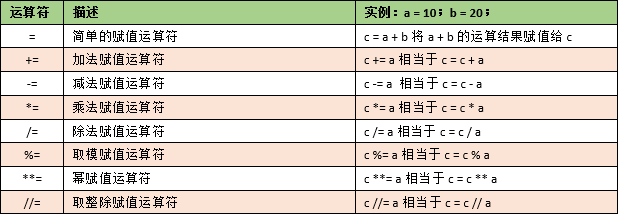Python运算符
-
算术运算符
-
比较(关系)运算符
-
赋值运算符
-
逻辑运算符
-
成员运算符
-
位运算符
-
身份运算符
-
运算符优先级
1.算术运算符

实例:
----------------加法----------------- a = 10 b = 3 print(a + b) --------------运算结果-------------- 13 -----------------减法----------------- a = 10 b = 3 print(a - b) --------------运算结果--------------- 7 -----------------乘法---------------- a = 10 b = 3 print(a * b) --------------运算结果--------------- 30 ---------------除法------------------- a = 10 b = 3 print(a / b) --------------运算结果--------------- 3.3333333333333335 ---------------取模------------------ a = 10 b = 3 print(a % b) ---------------运算结果-------------- 1 --------------幂---------------------- a = 10 b = 3 print(a ** b) ---------------运算结果-------------- 1000 -----------------取整除-------------- a = 10 b = 3 print(a // b) ---------------运算结果---------------- 3
2.比较运算符

例子:
a = 10
b = 3
if a == b :
print("a等于b")
else :
print("a不等于b")
if a < b :
print("a小于b")
else :
print("a大于b")
-------------输出结果------------------
a不等于b
a大于b
3.赋值运算符

例子:
a = 10 b = 5 c = a + b print(c) a = 20 c = 30 c+=a print(c) -----------------输出结果------------ 15 50
4.逻辑运算符

运算逻辑符判断的顺序:括号()-----> not -----> and ----->or
x or y:
若 x 是零,输出y;若x是非零,输出x
例子:
1.判断1 == 3 or 4 == 4 and 2 == 3 or 3 == 3的结果
print(1 == 3 or 4 == 4 and 2 == 3 or 3 == 3) -------------输出结果-------------------- True ----------------------------------------- 快速判断小秘诀
真 or = 真 真 and = 继续 假 or = 继续 假 and = 假
2.求出下列逻辑语句的值
1)8 or 3 and 4 or 2 and 0 or 9 and 7
2) 0 or 2 and 3 and 4 or 6 and 0 or 3
print(8 or 3 and 4 or 2 and 0 or 9 and 7) print(0 or 2 and 3 and 4 or 6 and 0 or 3) ---------------------------输出结果------------------------------ 8 4
3.下列结果是什么?
1) 6 or 2>1 2) 3 or 2>1 3) 0 or 5<4 4) 5<4 or 3 5) 2>1 or 6
6) 3 and 2>1 7) 0 and 3>1 8) 2>1 and 3 9) 3>1 and 0
10) 3>1 and 2 or 2<3 and 3 and 4 or 3>2
|
1
2
3
4
5
6
7
8
9
10
11
12
13
14
15
16
17
|
[root@wolaixunshan ~]# cat py.py#!/usr/bin/python3#-*- coding:UTF-8 -*-#Author:zjk#mail:zjkmmd@163.com#Time:2018-07-28 09:44:28#Name:py.py#Version:V1.0#Description:This is a script.print(6 or 2>1,3 or 2>1,0 or 5<4,5<4 or 3,2>1 or 6)print(3 and 2>1,0 and 3>1,2>1 and 3,3>1 and 0,3>1 and 2 or 2<3 and 3 and 4 or 3>2)---------------------------------------输出结果--------------------------------------[root@wolaixunshan ~]# python3 py.py6 3 False 3 TrueTrue 0 3 0 2 |
5.成员运算符

例子:
a = int(input(">>>"))
b = [1, 2, 3, 4, 5, 6, 7, 8, 9]
if a in b :
print("a在b中")
else :
print("a不在b中")
-----------输出结果------------------
>>>4
a在b中
>>>101
a不在b中
a = int(input(">>>"))
b = [1, 2, 3, 4, 5, 6, 7, 8, 9]
if a not in b :
print("a不在b中")
else :
print("a在b中")
-----------------输出结果------------------
>>>10
a不在b中
>>>3
a在b中
6.位运算符
按位运算符是把数字看作二进制来进行计算的。Python中的按位运算法则如下:
下表中变量 a 为 60,b 为 13,二进制格式如下:
a = 0011 1100 b = 0000 1101 ----------------- a&b = 0000 1100 a|b = 0011 1101 a^b = 0011 0001 ~a = 1100 0011

例子:
a = 60 # 60 = 0011 1100
b = 13 # 13 = 0000 1101
# --------------
print(a & b) # 12 = 0000 1100
---------------输出结果----------------
12
--------------------------------------
a = 60 # 60 = 0011 1100
b = 13 # 13 = 0000 1101
# --------------
print(a | b) # 61 = 0011 1101
---------------输出结果----------------
61
--------------------------------------
a = 60 # 60 = 0011 1100
b = 13 # 13 = 0000 1101
# --------------
print(a ^ b) # 49 = 0011 0001
----------------输出结果----------------
49
---------------------------------------
a = 60 # 60 = 0011 1100
b = 13 # 13 = 0000 1101
# --------------
print(~a) # -61 = 1100 0011, ~a相当于-a-1 = -60-1 = -61
----------------输出结果----------------
-61
--------------------------------------
a = 60 # 60 = 0011 1100
b = 13 # 13 = 0000 1101
# --------------
print(a << 2) #240 = 1111 0000
-----------------输出结果--------------
240
--------------------------------------
a = 60 # 60 = 0011 1100
b = 13 # 13 = 0000 1101
# --------------
print(b >> 2) # 3 = 0000 0011
------------------输出结果-------------
3
7.身份运算符
身份运算符用于比较两个对象的存储单元(内存地址)是否一样;

注: id() 函数用于获取对象内存地址。
说明:
只要是列表、字典、元组、set集合,这些的数据类型的相同值的内存地址一定不一样;
小数据池:
str:长度超过20位的、有特殊字符的比如空格,-+*等等;内存地址都不一样;
int:范围-5~256,在此范围内创建的相同数字都指向同一个内存地址,包括-5和256;
例子:
------------------------------------------------
a = 10
b = 10
print(id(a)) #获取变量a的内存地址
print(id(b)) #获取变量b的内存地址
if a is b :
print("True")
else :
print("False")
----------------------输出结果------------------
1613092032 #可以看出a的内存地址和b的内存地址一样,说明a和b引
1613092032 #用的是同一个对象
True
注意:
is 与 == 区别;
is用于判断两个变量引用对象是否为同一个;==用于判断引用变量的值是否相等。
例如:
---------- is --------------
a = str(10)
b = "10"
print(id(a))
print(id(b))
if a is b :
print("True")
else :
print("False")
------------输出结果------------
35284608
30655712
False
---------- == ---------------
a = str(10)
b = "10"
print(id(a))
print(id(b))
if a == b :
print("True")
else :
print("False")
-----------输出结果---------------
8676992
2147552
True
8.运算符优先级
一下表格列出了从最高到最低优先级的所有运算符:

例子:
a = (1 + 3) * 4 / 2 b = ((2 + 7) / 3 + 10 * 2) c = (3 + 9) * (2 ** 3) print(a) print(b) print(c) ----------------输出结果-------------------- 8.0 23.0 96
